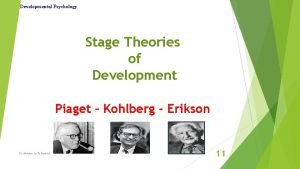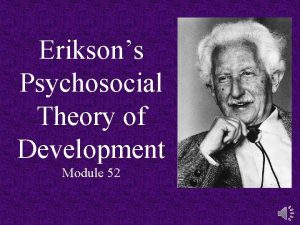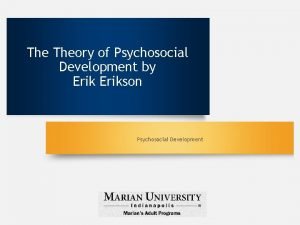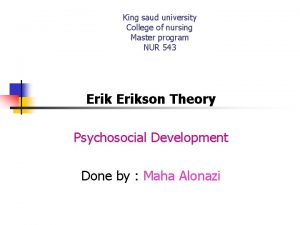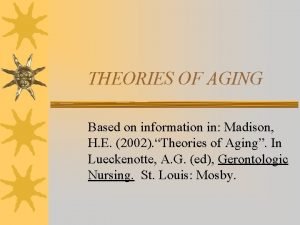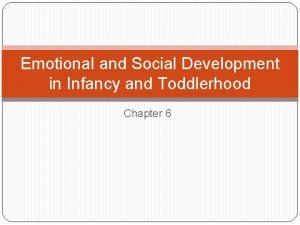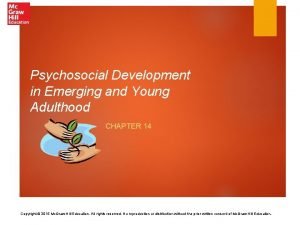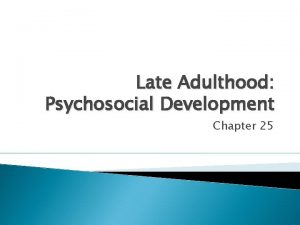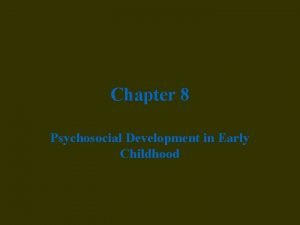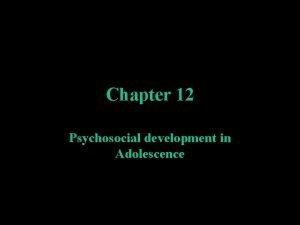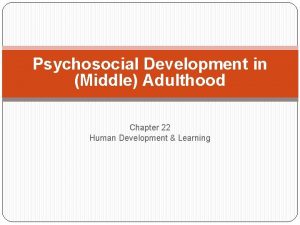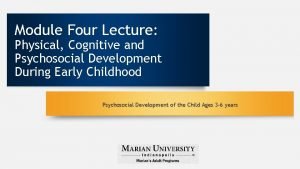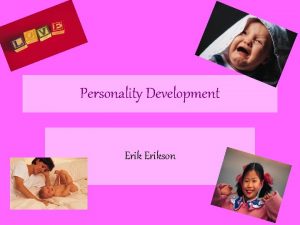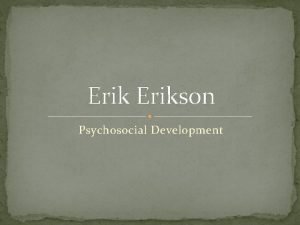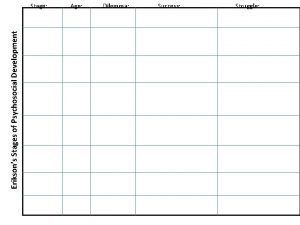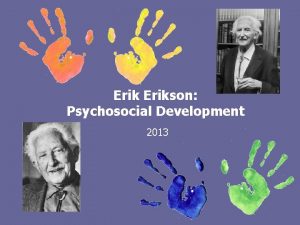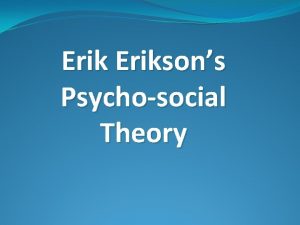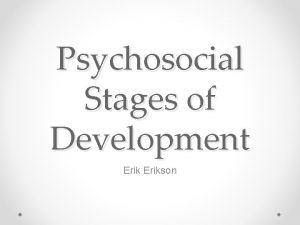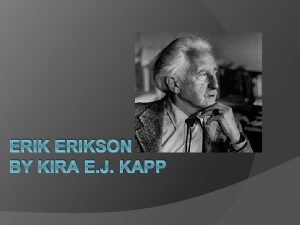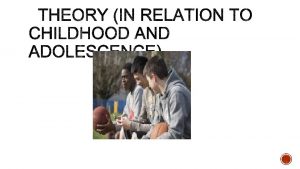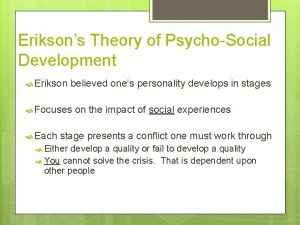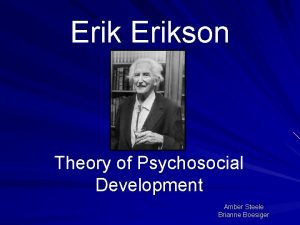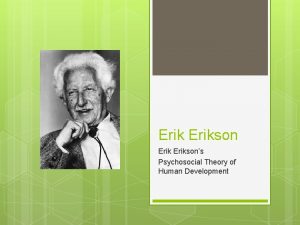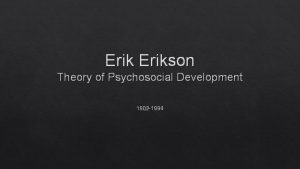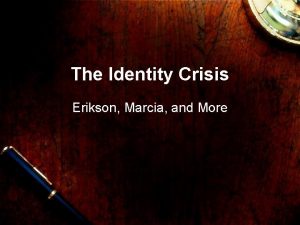Erikson Psychosocial Development Psychosocial Development Theory Psychosocial development






















- Slides: 22

Erikson: Psychosocial Development

Psychosocial Development Theory • Psychosocial development theory is based on eight stages of development • Erikson’s theory is based on the idea that development through life is a series of stages which are each defined by a crisis or challenge • The early stages provide the foundations for later stages so Erikson says that if a child does not resolve a crisis in a particular stage, they will have problems in later stages • For example, if an adolescent does not establish their own identity, they will have difficulty in relationships as an adult


The stages are as follows: • Stage 1 – Oral Sensory • Stage 2 – Muscular-Anal • Stage 3 – Muscular-Anal • • • Stage Stage 4 5 6 7 8 – – – Latency Adolescence Young Adulthood Middle Adulthood Maturity

Stage 1 – Oral Sensory Trust vs. Mistrust • birth to 1 year (infancy) • basic conflict is trust vs. mistrust • the important event is feeding and the important relationship is with the mother • the infant must develop a loving, trusting relationship with the mother/caregiver through feeding, teething and comforting • failure to resolve this conflict can lead to sensory distortion, and withdrawal

Trust vs. Mistrust This stage is all about fulfilling needs. The baby needs to trust the world around them to take care of their needs. If they are hungry, they need to develop trust that they will be fed. If they are not fed, or their diaper is left dirty, they may develop a mistrust in the outside world. This sense of trust of mistrust can effect us throughout the rest of our lives.

Stage 2 – Muscular-Anal Autonomy versus Shame and Doubt • age 1 to 3 years (toddler) • Basic conflict is autonomy vs. shame/doubt • The important event is toilet training and the important relationship is with the parents • The child’s energy is directed towards mastering physical skills such as walking, grasping and muscular control • The child learns self control but may develop shame, doubt, impulsivity or compulsion if not handled well

Autonomy vs. Shame & Doubt Autonomy means being your own boss. Here a toddler tries to control their own bodies by toilet training and their environment, by always saying "NO!!!!". Sometimes they do poopy in their pants or get yelled at by their parents, causing shame and doubt in their own abilities. If we learn how to control ourselves in reasonable ways, we develop a healthy will. We are then able to face the later challenges of life.

Stage 3 – Locomotor Initiative versus guilt • age 3 to 6 years (preschool) • basic conflict is initiative vs. guilt • the important event is independence and the important relationship is family • the child continues to become more assertive in exploration, discovery, adventure and play • the child may show too much force in this stage causing feelings of guilt • failure to resolve this conflict can lead to ruthlessness and inhibition

Initiative vs. Guilt Here the key word in a child's life changes from "No!" to why? ". In this stage children want to understand the world and they ask too many darn questions!!!! If their initiative in questioning the world is encouraged, then they will feel comfortable with expressing their curiosity throughout the rest of their life. If we discourage them and tell them to shut up, then they will feel guilty about their questioning and avoid being inquisitive later.

Stage 4 – Latency Industry vs. Inferiority • age 6 to 12 years (school age) • the basic conflict in this stage is industry vs. inferiority • the important event is school and the important relationships are teachers, friends and neighbourhood • the child must learn to deal with new skills and develop a sense of achievement and accomplishment • failure to do so can create a sense of inferiority, failure and incompetence

Industry vs. Inferiority This is where most children begin formal education (what we call school). For the first time children are being formally evaluated. If a child raises their hand in class and answers a question correctly, then he/she will feel industrious (competent). If he/she tries to answer a question but stutters to get out the wrong answer, and other students all start making fun of his/her speech impediment, then the child will feel inferior.

Stage 5 – Adolescence Identity vs. Role Confusion • age 12 to 20 years (adolescent) • the basic conflict is identity vs. role confusion • the important event is development of peer relationships and the important relationships are peers, groups and social influences • The teenager must achieve a sense of identity in occupation, sex roles, politics and religion. In addition, they must resolve their identity and direction. • Failure to make these resolutions can lead to the repression of aspects of the individual for the sake of others (fanaticism)

Identity vs. Role Confusion In adolescence, Erikson believed that a teenager’s main social need is to discover his or her social identity. While searching for your identity, you may try out different roles, like trying to fit into various social groups, experimenting with drugs or sex, or just changing your wardrobe. You should be trying to find a stable sense of self now, or Erikson believed you may have an identity crisis later.

Stage 6 – Young Adulthood Intimacy vs. Isolation • age 20 to 40 years • the basic conflict in young adulthood is intimacy vs. isolation • the important event is parenting and the important relationships are lovers, friends and work connections • in this stage, the individual must develop intimate relationships through work and social life • failure to make such connections can lead to promiscuity, exclusivity and isolation

Intimacy vs. Isolation Young adults (early 20 s into early 30 s) are trying to balance their career efforts (work, school or selfimprovement) with the need to be in an intimate relationship with another person. How much time should I spend looking for a relationship? What if I don't find anybody? What if I am all alone for the rest of my life?

Stage 7 – Middle Adulthood Generativity vs. Stagnation • age 40 to 65 years • the basic conflict is generativity vs. stagnation • the important event is parenting and the important relationships are with children and the community • this stage is based on the idea that each adult must find a way to satisfy, support and contribute to the next generation; it is often thought of as giving back • failure to resolve this stage can lead to overextension or rejectivity

Generativity vs. Stagnation Erikson believed that by the time we reach our mid 30 s to mid 50 s we start to really examine our lives and see if it is going the way we planned it or did it take a drastic turn. This is where some people take drastic steps and change their lives. You could see a lot of late divorces or extreme changes in clothes or cars- we call this experience a mid life crisis.

Stage 8 – Maturity Integrity vs. Despair • age 65 to death • the basic conflict is ego integrity vs. despair • the important event is reflection on and acceptance of the individual’s life • the individual is creating meaning and purpose of one’s life and reflecting on life achievements • failure to resolve this conflict can create feelings of disdain & despair.

Integrity vs. Despair Towards the end of our lives we look back and evaluate ourselves. Did we live a good life? Leave behind a legacy of friends or family? Or did we waste our time playing Madden 2023 on Playstation 7? If we feel like there were many lost opportunities along the way we may fall into despair. I like to use this stage to try to shape my life nowyou should too.

LET’S REVIEW 1. Can feel despair if conflict isn’t resolved in this stage. 2. Stage when parents are the important relationship and independence is the event. 3. Stage when event is potty training. 4. Stage when identity is rooted in occupation and peers are important. 5. Stage when the mother or caregiver is important. 6. Conflict is industry vs. inferiority. 7. Giving back is important during this stage.

Answers to Review • 1. Stage 8; Maturity (integrity vs despair) • 2. Stage 3; Locomotor (initiative vs guilt) • 3. Stage 2; Muscular-Anal (autonomy vs shame & doubt) • 4. Stage 5; Adolescence (identity vs role confusion) • 5. Stage 1; Oral Sensory (trust vs mistrust) • 6. Stage 4; Latency (industry vs inferiority) • 7. Stage 7; Middle Adulthood (generativity vs stagnation)
 Erikson's psychosocial theory of development
Erikson's psychosocial theory of development Industry vs. inferiority
Industry vs. inferiority Psychosocial stages
Psychosocial stages Developmental crisis
Developmental crisis Erikson's psychosocial crisis
Erikson's psychosocial crisis Erickson's psychosocial theory of development
Erickson's psychosocial theory of development Erikson's psychoanalytic theory of development
Erikson's psychoanalytic theory of development Peck's expansion of erikson's theory
Peck's expansion of erikson's theory Erikson's industry vs inferiority
Erikson's industry vs inferiority According to erikson's theory, a mistrustful baby
According to erikson's theory, a mistrustful baby Infancy psychosocial development
Infancy psychosocial development Psychosocial development in young adulthood
Psychosocial development in young adulthood Psychosocial development in late adulthood
Psychosocial development in late adulthood Stages of psychosocial development
Stages of psychosocial development Psychosocial development in early childhood
Psychosocial development in early childhood Psychosocial development in adolescence
Psychosocial development in adolescence Early adulthood emotional development 19-45
Early adulthood emotional development 19-45 Permaparenting
Permaparenting Define physical cognitive and psychosocial development
Define physical cognitive and psychosocial development Relazied
Relazied Eriksons first stage
Eriksons first stage Generativity stage
Generativity stage Erikson developmental stages
Erikson developmental stages
